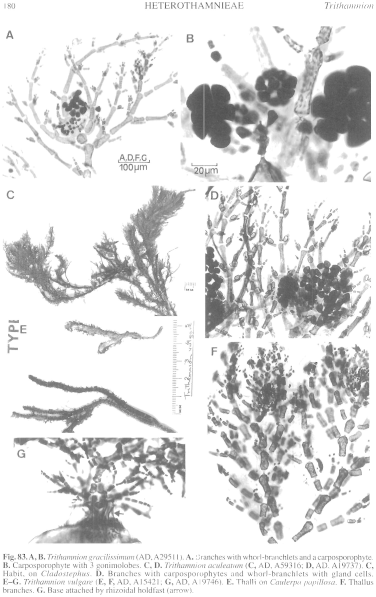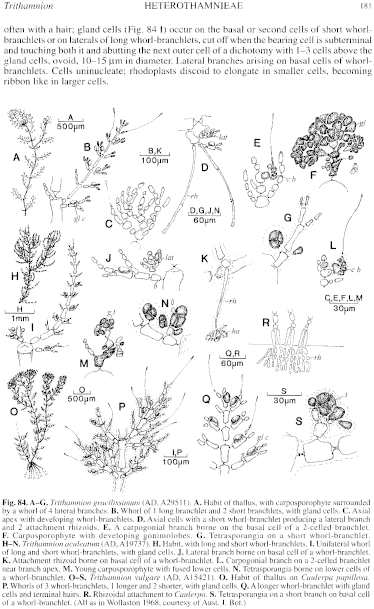|
|
|
|
|
|||||||||||
|
Electronic Flora of South Australia Species Fact Sheet
Phylum Rhodophyta – Order Ceramiales – Family Ceramiaceae – Tribe Heterothamnieae
Selected citations: Athanasiadis 1996: 99, fig. 42(?). Huisman 1997: 200.
Thallus (Figs 83A, 84A) with prostrate axes and erect branches to 5 mm high, each axial cell bearing (2–) 3 (–4) whorl-branchlets with a longer central branchlet or indeterminate branch between a pair of short branchlets (Fig. 84A, B). Attachment by rhizoids (Fig. 84D) of elongate cells with terminal branched haptera, arising from the basal cells of whorl-branchlets on prostrate axes; epiphytic. Structure. Apical cells 5–7 µm in diameter and L/D 1–1.2, enlarging after 6–8 cells to axial cells 25–55 µm in diameter and L/D 4–6, with the whorl-branchlets separated. Long whorl-branchlets (Figs 83A, 84A, B) 100–250 µm and 6–10 cells long but extending to indefinite branches, with each rachis cell bearing 2–3 short branches (1–) 2–3 (–5) cells long, sometimes further branched and often with 2 (–3) small stalk cells with or without hairs; rachis cells 10–15 µm in diameter and L/D 4–6, basal cell shorter and usually unbranched, tapering to terminal cells 4–6 µm long and L/D 1.5–2; gland cells (Fig. 84B) occur on branches of long whorl-branchlets or on short whorl-branchlets, usually on and touching only the subterminal cell below the terminal pair of small cells, ovoid, 8–12 µm in diameter. Lateral branches extending from long whorl-branchlets or arising on the basal cell of whorl-branchlets (Fig. 83D). Cells uninucleate; rhodoplasts discoid, elongate or in longitudinal chains in larger cells.
Reproduction: Carpogonial branches (Fig. 84E) occur on the basal cell of a short-branchlet, the terminal cell forming a sterile cell on the supporting cell; apical axial growth ceases on development of the procarp. The auxiliary cell is cut off from the supporting cell and after fusion with the carpogonium forms a lower foot cell and upper central cell, which develops a terminal gonimolobe and 4–6 lateral rounded gonimolobes (Figs 83B, 84F) 50–80 µm across of ovoid carposporangia 18–22 µm in diameter, surrounded by 2–4 long whorl-branchlets (Figs 83A, 84A) from the axial cell below. Spermatangia unknown.
Tetrasporangia (Fig. 84G) are borne on the basal cells of short whorl-branchlets, sessile, ovoid, 35–40 µm in diameter, tetrahedrally to subdecussately divided.
Type from Saunders Beach, Kangaroo I., S. Aust., on Chondria, drift (Womersley, 25.viii.1963); holotype in AD, A29511.
Selected specimens: Houtman Abrolhos, W. Aust., (Huisman 1997, p. 200). Middleton Beach, Albany, W. Aust., on Hymenocladia, drift (R.D. Wood, 10.x.1960; AD, A24570). Port Willunga, S. Aust., on Dictyota, upper sublittoral (Wollaston, 23.xi.1958; AD, A29510). Rocky Cape, Tas., on Cystophora torulosa, drift (Gordon, 18.i.1966; AD, A29951).
Distribution: Houtman Abrolhos, W. Aust., to Rocky Cape, Tas. (at scattered localities).
References:
ATHANASIADIS, A. (1996). Morphology and classification of the Ceramioideae (Rhodophyta) based on phylogenetic principles. Opera Botanica No. 128, pp. 1–216.
HUISMAN, J.M. (1997). Marine Benthic Algae of the Houtman Abrolhos Islands, Western Australia. In Wells, F.E. (Ed.) The Marine Flora and Fauna of the Houtman Abrolhos Islands, Western Australia, pp. 177–237. (W. Aust. Museum: Perth.)
WOLLASTON, E.M. (1968).Morphology and taxonomy of southern Australian genera of Crouanieae Schmitz (Ceramiaceae, Rhodophyta). Aust. J. Bot. 16, 217–417.
The Marine Benthic Flora of Southern Australia Part IIIC complete list of references.
Publication:
Womersley, H.B.S. (24 December, 1998)
The Marine Benthic Flora of Southern Australia
Rhodophyta. Part IIIC. Ceramiales – Ceramiaceae, Dasyaceae
©State Herbarium of South Australia, Government of South Australia
Illustrations in Womersley Part IIIA, 1998: FIGS 83A, B, 84 A–G.

Figure 83 enlarge
Fig. 83. A, B. Trithamnion gracilissimum (AD, A29511). A. Branches with whorl-branchlets and a carposporophyte. B. Carposporophyte with 3 gonimolobes. C, D. Trithamnion aculeatum (C, AD, A59316; D, AD, A19737). C, Habit, on Cladostephus. D. Branches with carposporophytes and whorl-branchlets with gland cells. E–G. Trithamnion vulgare (E, F, AD, A15421; G, AD, A19746). E. Thalli on Caulerpa pupillosa. F. Thallus branches. G. Base attached by rhizoidal holdfast (arrow).

Figure 84 enlarge
Fig. 84. A–G. Trithamnion gracilissimum (AD, A29511). A. Habit of thallus, with carposporophyte surrounded by a whorl of 4 lateral branches. B. Whorl of 1 long branchlet and 2 short branchlets, with gland cells. C. Axial apex with developing whorl-branchlets. D. Axial cells with a short whorl-branchlet producing a lateral branch and 2 attachment rhizoids. E. A carpogonial branch borne on the basal cell of a 2-celled branchlet. F. Carposporophyte with developing gonimolobes. G. Tetrasporangia on a short whorl-branchlet. H–N. Trithamnion aculeatum (AD, A 19737). H. Habit, with long and short whorl-branchlets. I. Unilateral whorl of long and short whorl-branchlets, with gland cells. J. Lateral branch borne on basal cell of a whorl-branchlet. K. Attachment rhizoid borne on basal cell of a whorl-branchlet. L. Carpogonial branch on a 2-celled branchlet near branch apex. M. Young carposporophyte with fused lower cells. N. Tetrasporangia borne on lower cells of a whorl-branchlet. O–S. Trithamnion vulgare (AD, A15421). O. Habit of thallus on Caulerpa papillosa. P. Whorls of 3 whorl-branchlets, 1 longer and 2 shorter, with gland cells. Q. A longer whorl-branchlet with gland cells and terminal hairs. R. Rhizoidal attachment to Caulerpa. S. Tetrasporangia on a short branch on basal cell of a whorl-branchlet. (All as in Wollaston 1968, courtesy of Aust. J. Bot.)

|
Email Contact: State Herbarium of South Australia |

|